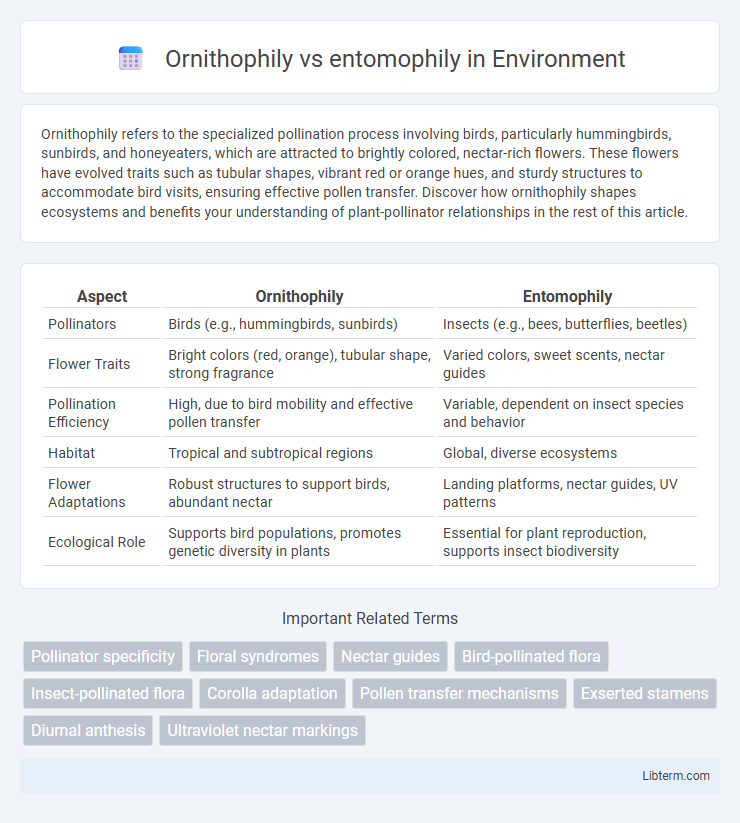Ornithophily refers to the specialized pollination process involving birds, particularly hummingbirds, sunbirds, and honeyeaters, which are attracted to brightly colored, nectar-rich flowers. These flowers have evolved traits such as tubular shapes, vibrant red or orange hues, and sturdy structures to accommodate bird visits, ensuring effective pollen transfer. Discover how ornithophily shapes ecosystems and benefits your understanding of plant-pollinator relationships in the rest of this article.
Table of Comparison
| Aspect | Ornithophily | Entomophily |
|---|---|---|
| Pollinators | Birds (e.g., hummingbirds, sunbirds) | Insects (e.g., bees, butterflies, beetles) |
| Flower Traits | Bright colors (red, orange), tubular shape, strong fragrance | Varied colors, sweet scents, nectar guides |
| Pollination Efficiency | High, due to bird mobility and effective pollen transfer | Variable, dependent on insect species and behavior |
| Habitat | Tropical and subtropical regions | Global, diverse ecosystems |
| Flower Adaptations | Robust structures to support birds, abundant nectar | Landing platforms, nectar guides, UV patterns |
| Ecological Role | Supports bird populations, promotes genetic diversity in plants | Essential for plant reproduction, supports insect biodiversity |
Introduction to Ornithophily and Entomophily
Ornithophily refers to pollination by birds, especially hummingbirds, sunbirds, and honeycreepers, characterized by flowers with bright colors, tubular shapes, and abundant nectar to attract avian pollinators. Entomophily involves insect pollination, primarily by bees, butterflies, and beetles, with flowers often featuring scented nectar guides, diverse shapes, and pollen structures adapted to insect visitors. These two pollination syndromes highlight evolutionary adaptations in floral traits to optimize reproduction through specific animal pollinators.
Defining Ornithophily: Bird Pollination Explained
Ornithophily refers to pollination primarily facilitated by birds, particularly hummingbirds, sunbirds, and honeyeaters, which are attracted to brightly colored, tubular flowers rich in nectar. This bird pollination strategy contrasts with entomophily, where insects like bees and butterflies are the main pollinators, usually drawn to flowers with sweet fragrances and landing platforms. Ornithophilous plants have adapted to withstand pecking and often produce copious amounts of nectar to meet the high energy demands of their avian pollinators.
Understanding Entomophily: Insect-Mediated Pollination
Entomophily, the process of insect-mediated pollination, plays a crucial role in the reproduction of numerous flowering plants by facilitating pollen transfer from anthers to stigmas via insects like bees, butterflies, and beetles. This type of pollination enhances genetic diversity and crop yields by promoting effective pollen dispersal and plant fertilization. In contrast to ornithophily, which involves bird pollinators, entomophily benefits from the vast diversity and abundance of insect pollinators, making it a dominant mechanism in many ecosystems.
Floral Adaptations for Bird Pollinators
Floral adaptations for bird pollinators, characteristic of ornithophily, include bright red or orange tubular flowers that accommodate long beaks and hovering flight. These flowers often produce copious amounts of dilute nectar as an energy-rich reward, lacking strong scents since birds have poor olfactory senses. In contrast, entomophily involves flowers adapted for insect pollination, typically exhibiting diverse colors, strong fragrances, and nectar guides suited to insect vision and foraging behavior.
Flower Traits Favoring Insect Pollination
Flowers favoring entomophily typically exhibit bright colors such as blue, yellow, or ultraviolet patterns that specifically attract insects like bees and butterflies. These flowers often produce strong, sweet fragrances and offer nectar and pollen as food rewards to entice insect visitors. Structural traits include landing platforms and tubular shapes that accommodate insect anatomy, facilitating effective pollen transfer during feeding.
Comparative Ecology: Birds vs Insects as Pollinators
Ornithophily and entomophily represent distinct pollination strategies shaped by the ecology of birds and insects, respectively. Bird pollinators, such as hummingbirds and sunbirds, are attracted to brightly colored, tubular flowers with abundant nectar, enabling efficient pollen transfer over long distances due to their strong flight capabilities. In contrast, insect pollinators like bees and butterflies favor flowers with diverse shapes and scents, relying on intricate behavioral patterns and shorter foraging ranges that promote localized gene flow within plant populations.
Evolutionary Advantages of Ornithophily
Ornithophily, or bird pollination, offers evolutionary advantages such as enhanced pollen dispersal over longer distances due to birds' high mobility and territorial behavior. Flowers adapted to ornithophily typically exhibit bright colors and abundant nectar, optimizing attraction to birds while reducing competition with insect pollinators. This specialization can lead to increased reproductive success and genetic diversity compared to entomophily, which relies on insects with generally shorter foraging ranges.
Entomophily and Plant Biodiversity
Entomophily, the pollination of plants by insects, is a critical driver of plant biodiversity, enabling cross-pollination and genetic variation in over 80% of flowering plants. Insect pollinators such as bees, butterflies, and beetles facilitate the reproduction of diverse plant species, which supports complex ecosystems and agricultural productivity. The co-evolution between entomophilous plants and their insect pollinators has resulted in specialized floral structures and behaviors that maximize pollination efficiency and enhance species richness.
Impact of Environmental Changes on Pollination Strategies
Ornithophily, or bird pollination, often thrives in environments where floral traits such as bright colors and robust nectar production attract avian species, but habitat loss and climate shifts can disrupt these specialized interactions. Entomophily, relying on insect pollinators like bees and butterflies, faces challenges from pesticide use and temperature fluctuations that reduce insect populations and pollination efficiency. Environmental changes thereby alter pollination dynamics, influencing plant reproductive success and ecosystem stability by differentially impacting ornithophilous and entomophilous species.
Conclusion: Balancing Bird and Insect Pollination in Ecosystems
Balancing bird and insect pollination is essential for maintaining resilient and diverse ecosystems, as ornithophily supports the pollination of large, brightly colored flowers while entomophily primarily involves insects pollinating a wide range of smaller, often nectar-rich plants. Both pollination strategies contribute uniquely to plant reproductive success, genetic diversity, and ecosystem stability. Effective conservation efforts must protect habitats that sustain both bird and insect pollinators to ensure comprehensive pollination services and biodiversity preservation.
Ornithophily Infographic

 libterm.com
libterm.com